The magnificent allure of gliding through tranquil waters, surrounded by picturesque landscapes, is what initially drew me into the wonderful world of kayaking. This incredible, eco-friendly water sport is not only exhilarating and enjoyable but also offers an opportunity to improve your overall fitness and connect with Mother Nature.
However, learning the art of steering your trusty kayak is crucial to ensure a safe and enjoyable paddling experience. After spending countless hours experimenting and honing my kayaking skills, I am eager to share some of the knowledge I’ve gained to help fellow enthusiasts navigate their vessels with ease and confidence.
In this blog post on “How to steer a kayak”, I’ll cover everything from selecting the right kayak and paddle to perfecting essential paddling techniques and understanding environmental factors that affect your performance on the water. So buckle up and get ready to embark on a fantastic journey of mastering the art of kayak steering, as we paddle our way through a treasure trove of tips, tricks, and invaluable advice.
Contents
Contents
Choosing The Right Kayak & Paddle
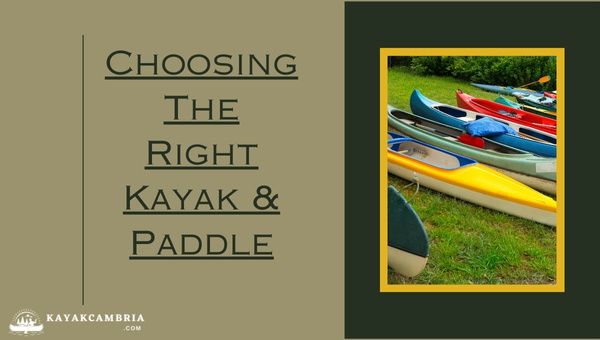
When I first started my kayaking journey, I quickly realized the importance of selecting the right kayak and paddle. The myriad of choices available can be overwhelming, but understanding the types of kayaks, lengths, and materials is crucial for a successful kayaking experience. Let me share some insights on making the best choice for your paddling needs.
Types Of Kayaks
There are various types of kayaks designed for different purposes. Some of the most common categories include:
- Recreational kayaks: Ideal for calm waters and suitable for beginners.
- Touring kayaks: Built for longer trips and designed to perform well in choppy waters.
- Whitewater kayaks: Specifically designed for tackling whitewater rapids.
- Sit-on-top kayaks: Suitable for warmer climates and easy to maneuver in and out of.
- Inflatable kayaks: Portable, lightweight option for those with limited storage space.
Consider your planned activities and environments before choosing the type of kayak that suits your needs.
Kayak Length
Selecting the right length of the kayak greatly influences its maneuverability. As a general rule:
- Shorter kayaks (usually 8-12 feet): Easier to steer and better suited for small water bodies.
- Longer kayaks (usually 12-16 feet): Provide better tracking, increased stability, and ample storage space, making them ideal for extended trips.
Paddle Selection
Paddle selection is another crucial aspect to consider. The primary factors I paid attention to when choosing my paddle included:
- Length: To find the appropriate paddle length, consider your kayak’s width and your height.
- Materials: Paddles are made from various materials like aluminum, fiberglass, or carbon fiber. Each material offers different advantages and drawbacks in terms of weight, durability, and cost.
- Blade shape: The shape of the paddle blade affects the stroke’s efficiency and the amount of force required. Common shapes include asymmetrical, symmetrical, and wing-shaped blades.
Investing time in assessing these key factors and understanding the kayak and paddle that best suit your requirements will ensure a comfortable and enjoyable paddling experience. Don’t hesitate to ask for advice from experienced paddlers or retailers, and always prioritize your safety and comfort while kayaking.
Understanding The Kayak’s Anatomy
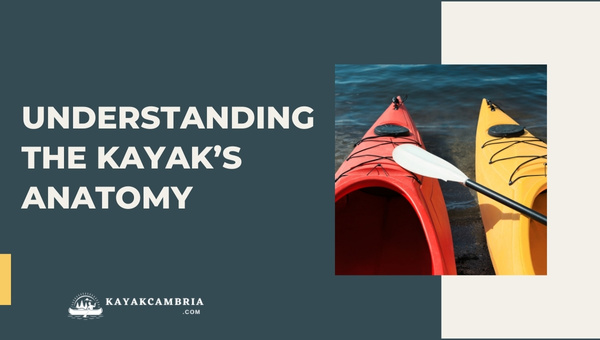
To effectively steer a kayak, it’s essential to familiarize ourselves with its basic anatomy. Here, I’ll discuss the primary components of a kayak that play a vital role in its performance and maneuverability in the water.
Bow
The bow is the front or the ‘pointed’ end part of a kayak. This part is responsible for cutting through the water and maintaining the direction of the vessel.
Stern
The stern refers to the back end of the kayak. Often flat or curved, the stern’s primary purpose is to assist in straight-line tracking and stability.
Hull
The kayak’s bottom, known as the hull, significantly impacts the vessel’s speed, maneuverability, and stability. There are two types of hulls: displacement and planing.
- Displacement hulls are rounded, making them faster, more maneuverable, and efficient for horizontal strokes.
- Planing hulls are flatter, allowing for higher speed while limiting the kayak’s ability to turn quickly.
Understanding the type of hull on your kayak will help you make better steering decisions.
Cockpit & Seat
The cockpit is where you sit, and sometimes even stand, during your kayaking adventure. The seat is located within the cockpit and is an essential factor in ensuring your comfort throughout your journey. Focus on finding a comfortable and well-ventilated seat with proper back support.
Deck
The deck, or the top of the kayak, is crucial for storage purposes, and it’s where deck lines, hatches, and bungee cords are located. Familiarize yourself with the deck’s features, as they can come in handy when securing items or help you maintain your balance while steering.
Thigh & Foot Braces
Thigh and foot braces not only provide additional support but also play a vital role in controlling the kayak while steering. The foot braces are adjustable and allow you to customize the position according to your leg length, while thigh braces offer increased control during turns and maneuvers.
Understanding the kayak’s anatomy ensures you not only become a proficient paddler but also help maintain your vessel correctly. This knowledge will come in handy when learning steering techniques and making vital kayaking decisions while exploring aquatic landscapes.
Proper Paddling Technique
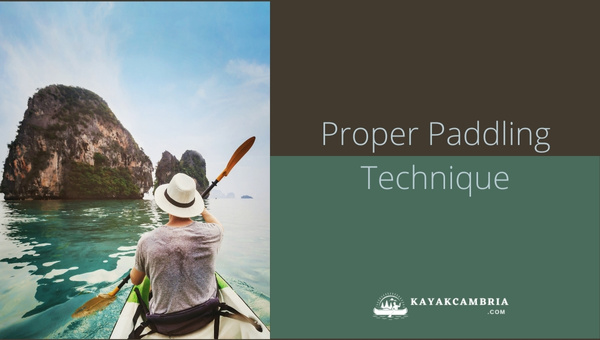
A crucial aspect of steering a kayak lies in mastering the proper paddling technique. This skill ensures efficient navigation while preventing muscle strain and potential injuries. Allow me to share some key paddling techniques I’ve honed during my time on the water:
Posture And Hand Position
Ideal posture: Sit up straight yet relaxed, with your feet resting on the footpegs and knees bent slightly outwards. This position allows for improved movement and better control over the kayak.
Hand position: Hold the paddle with a firm grip and your hands shoulder-width apart. Ensure your knuckles are in line with the paddle blades and use the control hand (the hand that remains in a fixed position) to control your paddle’s angle.
Basic Paddle Strokes
1. Forward Stroke: This stroke propels the kayak forward and serves as the most fundamental maneuver.
- Begin by submerging one paddle blade fully into the water near your toes, using your control hand.
- Rotate your torso and engage your core muscles to power the stroke, pulling the blade back towards your hip.
- As you finish that stroke, prepare the other paddle blade for entry on the opposite side. Remember to maintain good posture throughout this continuous motion.
2. Reverse Stroke: The reverse stroke slows down or moves your kayak backward. The technique is essentially the forward stroke executed in reverse.
- Fully submerge the paddle blade into the water near your hip, with your control hand leading.
- Push the paddle blade towards your toes while rotating your torso and engaging your core muscles.
- As you complete the stroke, prepare the other paddle blade for entry on the opposite side, maintaining proper posture throughout the motion.
Essential Kayaking Maneuvers
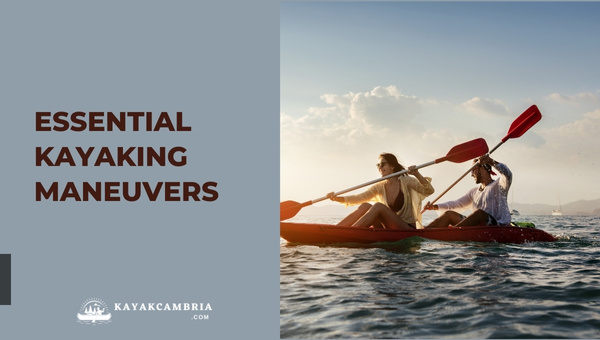
After mastering basic paddling techniques, it’s time to level up your skills by learning essential kayaking maneuvers. Being proficient in these moves will allow you to navigate your kayak with ease and precision. Below, I’ve outlined my go-to essential kayaking maneuvers.
Sweep Strokes
One of the most crucial techniques for steering a kayak is the sweep stroke. This maneuver shifts the kayak’s direction without the need for continuous back-and-forth switching of paddling sides.
Forward Sweep Stroke
The forward sweep stroke moves the kayak’s bow away from the paddle side. To perform this stroke, follow these steps:
- Start in a relaxed sitting position with your hands slightly wider than shoulder-width apart on the paddle.
- Keeping the paddle’s blade completely submerged, initiate the stroke by rotating your torso and extending the paddle forward.
- Perform a wide, sweeping motion with the paddle blade by pulling it towards the stern. Remember to keep the motion parallel to the kayak’s hull.
- Complete the stroke by bringing the paddle close to the stern and alongside the kayak.
Reverse Sweep Stroke
When you need to move the stern away from the paddle side, the reverse sweep stroke comes handy. To execute it, follow these instructions:
- Begin with the paddle at the stern and the blade fully submerged in water.
- Push the paddle forward away from the stern while maintaining a wide arc, all the way to the kayak’s bow.
- Finish the stroke by pulling the paddle towards the bow and along the hull.
Draw Strokes
Another valuable skill for steering is the draw stroke, which moves the kayak sideways without changing its direction. Two popular variations of this stroke are the sculling draw and the classic draw.
Sculling Draw
- Sit upright and extend the paddle on the side of the kayak you wish to move towards.
- Tilt the paddle blade at a slight angle to the water, with the leading edge slightly raised.
- Sweep the paddle blade back and forth in a ‘sculling’ motion to generate the necessary force to move the kayak.
Classic Draw
- Extend the paddle on the side you want to move towards, keeping the blade parallel to the kayak.
- Pull the paddle towards the kayak.
- Slide the paddle forward to release water and prevent unnecessary forward motion.
Edging
The technique of edging enables a kayaker to steer smoothly around turns and negotiate obstacles. This maneuver involves leaning the kayak’s hull on one side while keeping your body weight centered. Here’s how:
- Sit upright in the kayak and maintain a secure grip on the paddle.
- Shift and drop one of your hips to tilt the kayak slightly to the opposite side. Keep your upper body stable and centered.
- Use sweep strokes and draw strokes to navigate the kayak while maintaining the tilted position.
Weather & Environmental Factors
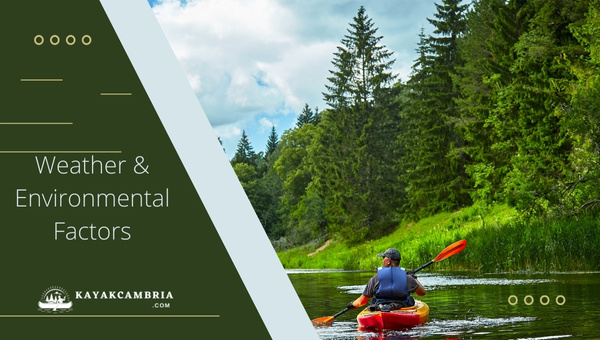
The key to steering your kayak efficiently and confidently under various conditions lies in your ability to adapt to the weather and environmental factors prevailing during your adventure. Here are some crucial elements that you need to be aware of:
Wind
Wind can significantly influence your kayaking experience, as it affects the direction and speed of your kayak. It’s crucial to keep an eye on the wind direction and learn how to adjust your paddling techniques accordingly:
- Paddling upwind – Lean slightly forward into the wind and use a slightly faster forward stroke on the upwind side to maintain control.
- Paddling downwind – Shift your weight slightly back, and use wider and smoother strokes to maintain balance.
Currents
Currents can make steering more challenging, particularly in rivers or tidal zones. Here’s how I adapt to steer effectively in such situations:
- Going with the current – Maintain a good distance from obstacles, and make use of your forward strokes and sweep strokes to steer effortlessly downstream.
- Paddling against the current – Choose a route with minimal resistance, and use more assertive paddle strokes to make headway upstream.
Waves
Waves can make steering a kayak particularly challenging, particularly on open water. Here are a few techniques I use to tackle waves safely:
- Crossing waves at an angle – As a rule of thumb, it’s best to keep your kayak’s bow facing into the wave, yet at an angle. This helps avoid capsizing and maintain control.
- Using edging – By applying the edging technique, you can tilt your kayak’s hull to ride over the waves without taking in water.
Water Temperature
Last but not least, always consider the water temperature before heading out on your kayaking adventure. Cold water can increase the risk of hypothermia, while warm water may lead to dehydration. Prepare yourself by using proper clothing, such as a wetsuit or drysuit, staying hydrated, and knowing your boundaries based on the water temperature.
Practicing Steering In Different Water Conditions
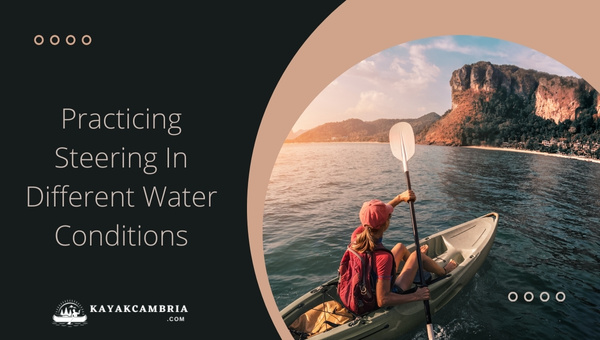
As I progressed in my kayaking journey, I realized the importance of practicing steering in various water conditions. The experience not only allowed me to master essential techniques, but it also heightened my spontaneity and adaptability as a kayaker. In this section, I’ll share with you invaluable tips on developing your steering skills in different water settings.
1. Calm Lakes
For beginners, I’d highly recommend starting your practice in a calm, sheltered waters like lakes to gain a solid grasp of basic kayak steering. Practicing on placid waters helps you build the paddling and steering techniques under more predictable conditions. Here, you’ll be able to focus on:
- Learning the forward, reverse, and sweep strokes
- Developing a natural sense of balance and coordination
2. Gentle Moving Rivers
Once you’re comfortable with handling your kayak on calm waters, it’s time to graduate to a more challenging environment with mild currents. Gentle moving rivers are an excellent choice for the next step, as they’ll introduce you to:
- The effects of currents on your kayak’s movement and steering
- Enhancing your steering skills by practicing draw strokes and *ferrying_ maneuvers
- Assessing and adapting to the river’s changing features, like eddies and whirlpools
3. Coastal Waters & Open Seas
For seasoned kayakers looking for a greater challenge, coastal waters and open seas can provide thrilling experiences. Be certain to consider local weather conditions and only venture out when conditions are favorable. When practicing steering in these environments, keep the following factors in mind:
- Develop proficiency in edging to better control and steer against the waves
- Learning to use a rudder or skeg to maintain the direction
- Practice paddling and steering in sync with swell patterns, tides, and waves
4. White-water Rivers
Steering through white-water rivers demands a high degree of skill and expertise; it’s advisable only for advanced kayakers. Maneuvering through turbulent waters will test your steering mastery and challenge you to:
- Learn how to swiftly and proficiently navigate through rapids and obstacles
- Gain an intricate understanding of river dynamics to plan your steering and paddling strategy
- Enhance your ability to make lightning-fast decisions in the heat of the action
Remember, while exploring different water environments, always practice within your skill level and follow safety guidelines. Knowing your limits and expanding your skills gradually will lead you to become a confident and proficient kayaker steering through various water conditions.
Safety First: Avoiding Hazards & Being Prepared
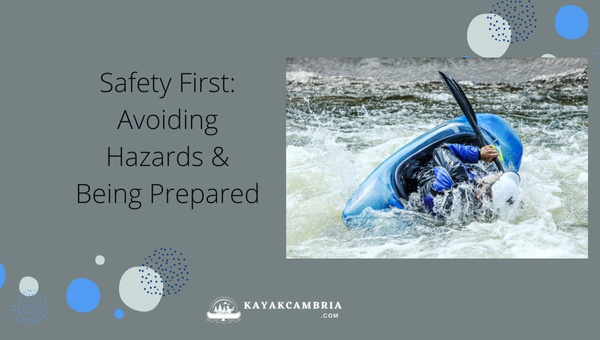
From my experience, prioritizing safety is paramount when it comes to steering a kayak and enjoying time on the water. Without proper precautions, even a seasoned kayaker can face unexpected challenges. Here are some essential safety guidelines every kayaker should adhere to while avoiding hazards and preparing for the unpredictable:
1. Personal Floatation Devices (PFDs)
Always wear a US Coast Guard-approved PFD (personal floatation device) while kayaking. It can potentially save your life in the event of a capsize or accident.
2. Dressing For The Occasion
Dress appropriately for the water temperature and weather conditions. In colder waters, consider wearing a wetsuit or dry suit to avoid hypothermia. In warmer weather, wearing a hat, sunglasses, and sunscreen will protect you from sunburn and heatstroke.
3. Check The Weather & Water Conditions
Keep a close watch on the weather forecast and water conditions. This way, you can assess potential hazards beforehand, such as strong currents, high winds, or rough waters. Having this knowledge enables you to alter your kayaking route or adjust your steering technique accordingly.
4. Knowledge Of First Aid & Basic Rescue Techniques
Familiarize yourself with basic first aid and rescue techniques, such as the Eskimo roll and the T-rescue. These skills can prove invaluable in emergency situations, and knowing how to perform them can make the difference between a successful rescue and a tragedy.
5. Communication & Signaling Devices
Always have a means of communication available, such as a whistle, flare, or VHF marine radio. In case you encounter trouble or need to signal for help, these devices ensure that you can quickly and effectively communicate with people nearby or search-and-rescue teams.
6. Adequate Nourishment And Hydration
To keep your energy levels up and prevent dehydration or heat exhaustion, don’t forget to pack appropriate amounts of food and water. For extended kayaking trips, consider bringing a water filtration system or water purification tablets.
7. Be Aware Of Surrounding Hazards
Stay vigilant about potential hazards, such as underwater rocks, logs, or debris. Always maintain a safe distance from motorized boats or other watercraft, and follow local regulations and guidelines for interacting with marine wildlife.
By following these essential safety guidelines, I’ve successfully avoided potential hazards and have been better prepared for any unforeseen issues that arise while out on the water.
Frequently Asked Questions
1. What is the best kayak for a beginner?
The best kayak for a beginner is typically a recreational or sit-on-top kayak. These kayaks are stable, easy to maneuver, and suitable for flat water conditions. Additionally, they tend to have a wider and more comfortable cockpit, making them perfect for newcomers.
2. How do I choose the right paddle for my kayak?
When choosing a kayak paddle, consider the paddle length, material, and blade design. Factors like your height, kayak width, and paddling style will help you determine the right paddle size. Popular paddle materials include aluminum, carbon fiber, and fiberglass, each with its pros and cons in terms of weight, durability, and cost.
3. How should I store my kayak when not in use?
When storing your kayak, make sure to keep it clean and dry. Store it on a soft surface to prevent dents and scrapes. Ideally, use kayak brackets or a rack system to store your kayak off the ground, either horizontally, on its side, or vertically. Additionally, it’s best to keep it away from direct sunlight to prevent UV damage.
4. Do I need a special permit to kayak?
Kayaking regulations vary depending on the location, so check with local authorities to find out if any permits or registration is necessary. Some places may require a boating license or permit, while others only need you to adhere to general boating regulations.
5. Is kayaking safe for individuals with limited mobility?
Kayaking can be a fantastic activity for individuals with limited mobility. Ensure to consult with a medical professional before embarking on your kayaking journey and consider using a kayak with features specifically designed for individuals with mobility challenges, such as outriggers for added stability or a wider cockpit for easier entry and exit.
6. What essentials should I bring on a kayaking trip?
Regardless of the duration of your trip, always bring essential safety gear, such as a personal floatation device, whistle, and bilge pump. Additionally, pack a map, compass, or GPS device for navigation, sun protection, extra clothing, and snacks. It is also a good idea to have a first-aid kit and repair kit on hand.
7. How can I improve my kayaking skills?
The best way to improve your kayaking skills is through practice and experience. Start with mastering basic paddling techniques and gradually challenge yourself with more advanced maneuvers. Additionally, consider taking kayaking classes or joining a club to learn from experienced paddlers and receive tips on how to improve your steering and navigation abilities.
Conclusion
Learning how to steer a kayak might seem daunting at first, but with the right guidance, practice, and perseverance, you’ll soon find yourself gliding effortlessly through the water, in complete control of your vessel. Remember to choose the right equipment, understand your kayak’s anatomy, use proper paddling techniques, master the essential maneuvers, and consider the environmental factors. Also, don’t forget to practice different water conditions and always prioritize safety while out on the water.
In the end, it’s all about finding harmony between your movements and the ever-changing elements surrounding you. So, embrace the challenge and stay dedicated to learning the art of steering a kayak, and soon you’ll experience the tranquility and joy that this beautiful activity has to offer. Happy paddling!

